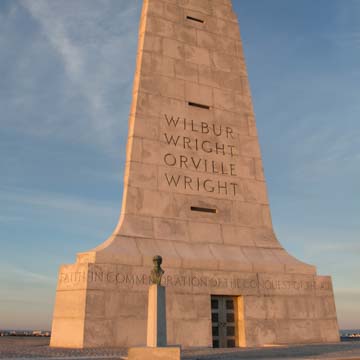The Wright Brothers National Memorial commemorates the site of Orville and Wilbur Wright’s historic powered flight at Kitty Hawk, North Carolina. The achievement has been called the seminal event in the history of aeronautics.
Orville and Wilbur Wright began their experiments with flight at their Dayton, Ohio, home while maintaining a bicycle manufacturing and repair shop. After developing a wing-warping technique with kites, the brothers wrote to the U.S. Weather Bureau and other aeronautical experimenters to determine a location suitable for future tests. Kitty Hawk was chosen for its open space, steady winds, and proximity. Here, the Wrights would experiment with gliders from 1900 to 1903, culminating on December 17, 1903, when Orville made his historic 12-second, 120-foot powered flight, landing at a point as high as its takeoff. Three additional flights were completed, the longest being 852 feet in 59 seconds. When the Wright brothers left Kitty Hawk to return to Ohio, the wooden hangar and buildings constructed for their use fell into disrepair. In 1911, when the brothers completely abandoned the site, the structures were completely destroyed by sand, wind, and weather.
The site remained unmarked until President Calvin Coolidge signed an act in 1927 that tasked the secretaries of War, Navy, and Commerce with appointing a Memorial Committee to oversee the design and construction of a memorial, with final design approval by the U.S. Commission of Fine Arts. The Memorial Commission appointed a jury to select a winning design; from 36 entries, the jury selected New York architectural firm Rodgers and Poor.
The monument was completed in 1932 on top of Kill Devil Hill, a large sand hill the Wright Brothers used as the takeoff point for their first powered flight. The shifting sand dune was stabilized with plantings by the War Department in 1928, after it had moved 200-300 yards from its original location during the first flight. The monument takes the form of nearly triangular obelisk, with a 60-foot-tall masonry shaft with sides measuring 36 by 43 by 43 feet. It sits atop the 90-foot-tall hill on a star-shaped terrace. Made of gray granite quarried from Mount Airy, North Carolina, both monument and terrace reveal strong ties to the then popular Art Deco movement. The sides of the shaft are ornamented with Art Deco bas-relief wings and the Wright brothers’ names are inscribed on the south wall. Surrounding the base is the inscription: “In commemoration of the conquest of the air by the brothers Wilbur and Orville Wright. Conceived by genius and achieved by dauntless resolution and unconquerable faith.” Double doors of nickel and stainless steel each feature four square bronze panels depicting images of flight. Inside, pink granite from Salisbury, North Carolina, lines the interior walls and the floor is black granite from Wisconsin. Stairs once allowed visitors to climb to an observation platform, but this was closed to the public in 1960. Capping the shaft is a glass cylinder holding a light once used as a beacon.
As part of the National Park Service’s Mission 66 program, the Philadelphia architectural firm Mitchell/Giurgola erected a Visitor Center at the Wright Brothers Memorial. Located 2,000 feet northeast of the monument, the single-story, concrete-and-glass building resembles a modern airport terminal, connecting the Wright brothers’ achievements to modern aviation. The reinforced concrete structure is arranged asymmetrically on a 128-foot-square platform. The east half of the platform is occupied by two parallel rectangular blocks with flat roofs that serve as the entry lobby, display area, restrooms, and offices. Connected to the display area is a 40-foot-square assembly room capped with a large dome—a thin concrete shell tied at its base by four tension rods. Cove-shaped overhanging eaves and 40 x 6–foot arched clerestory windows lend dramatic flair to the dome. Housed underneath the dome is a replica of the original 1903 Wright Flyer (the original is in the Smithsonian National Air and Space Museum).
When the Visitor Center was built, it reorganized the main approach from the south to a new entrance on U.S Route 158 to the east. The site is maintained by the National Park Service and is open to the public.
References
Allaback, Sarah. “Wright Brothers National Memorial Visitor Center, Kill Devil Hills, North Carolina.” In Mission Visitor Centers: The History of a Building Type, 67-94. Washington, D.C.: U.S. Department of the Interior, National Park Service, 2000.
Allaback, Sarah, and Ethan Carr, “Wright Brothers National Memorial Visitors Center,” Dare County, North Carolina. National Historic Landmark Nomination Form, 2000. National Park Service, U.S. Department of the Interior, Washington, D.C.
Bishir, Catherine W., and Michael T. Southern. A Guide to the Historic Architecture of Eastern North Carolina. Chapel Hill: University of North Carolina Press, 1996.
Chapman, Bill, and Jill Hanson, “Wright Brothers National Memorial (Additional Documentation),” Dare County, North Carolina. National Register of Historic Places Inventory–Nomination Form, 1996. National Park Service, U.S. Department of the Interior, Washington, D.C.
North Carolina History Project. “Wright Brothers National Memorial.” NorthCarolinahistory.org: An Online Encyclopedia. Accessed February 12, 2019. http://northcarolinahistory.org/.
Warfield, Ronald G., “Wright Brothers National Memorial,” Dare County, North Carolina. National Register of Historic Places Inventory–Nomination Form, 1976. National Park Service, U.S. Department of the Interior, Washington, D.C.
Williams, Wiley J. “Wright Brothers National Memorial.” NCpedia. Accessed January 28, 2019. http://ncpedia.org/.

